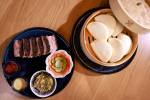Petrified by pie crust
Jack Bishop, editorial director of Cook's Illustrated magazine, doesn't think it's accurate that home cooks are afraid to make pie crusts.
"People are absolutely petrified by pie crust," Bishop said. " 'Afraid' is not strong enough. For a recipe that's got so few ingredients and is such a basic part of old-fashioned American cooking, the amount of fears regarding pie dough are quite high."
Whoever came up with "easy as pie" clearly didn't understand the psyche of the average American home cook. Jeanne Forrest, co-owner of Layers Bakery Cafe at 665 S. Green Valley Parkway in Henderson, sees the fear among her customers.
"It seems to throw people every year," Forrest said. "They're intimidated."
"There is a flakiness factor," agreed Treasa Teliska, co-owner of Pies Unlimited at 9310 Sun City Blvd. "It can be daunting."
But all of them maintain that you, too, can conquer the pie crust, without resorting to one of those frozen or refrigerated thingies, the use of which Bishop says automatically requires quotes if calling it a "homemade" pie.
"There's a misperception that it takes some sort of secret knowledge," he said. Or, "you need to have really cool hands -- some sort of genetic predisposition that's necessary to be able to make pie dough successfully."
Not true. The mystique, he said, grew out of the fact that pie is something home cooks prepare infrequently but usually in high-pressure holiday situations.
"They didn't make them as kids," Forrest said. "You don't hear a lot of people talk about making pies with their moms and grandmas. They made cookies."
First, bear in mind that there is no single "best" recipe for pie crust. Forrest uses all butter, and said her crusts are heavier than those made with shortening, but that the butter "adds a richness that you don't get with anything else." She also adds more salt than many, "because I like the sweetness of the fruit and the filling against the butteryness and saltiness of the crust. I think that makes a great combination." Her bakery makes them 40 at a time in a 60-quart mixer, and par-bakes the crusts (filled with foil and beans, to prevent bubbles) before adding the filling.
Teliska said her husband, Mike, uses only shortening and no butter, because it "makes our crusts really light and flaky. That's one of the biggest compliments we get." He uses pastry flour and a specialty mixer that works up and down, like hands, and mixes 180 crusts at a time. He doesn't pre-bake his crusts.
Bishop's magazine is affiliated with America's Test Kitchen, where professionals put recipes through their paces dozens and dozens of times, making sometimes minute changes, until they achieve optimum results. And while they offer an all-butter recipe "for people who won't use shortening" and a recipe with less fat for more delicate constructions, such as lattice tops, the recipe they consider "the most reliable in our arsenal" contains both butter and shortening. That's because of "our feeling about what is the best combination -- the flavor from butter and the flakiness from shortening," Bishop said.
It also contains a secret ingredient you're not likely to find anywhere else: vodka.
"The greatest struggle with pie dough is while you're rolling out the dough, you want as much water as possible, so it's easy to roll out," Bishop said. "A lot of recipes really skimp on the water or warn you about not adding too much water, because the water causes gluten to develop which, once formed and baked, adds to toughness. But skimp on the water and it's nearly impossible to work with the dough."
The vodka, he said, adds the moisture that makes the dough easier to handle, but doesn't form as much gluten as the water.
"It's a really easy dough to roll out," he said. "It doesn't crack as much, doesn't tear as much."
The local pie bakers have several other tips.
"I would say just be patient, don't overwork it," Teliska said. "Don't press it out too hard on the tin. Don't mix it too long."
Forrest said three things are key when making pie crusts.
"One, your fat has to be really cold," she said. "The second key is really, really cold water. Put it in the freezer."
And third, she also advised against overworking the dough.
"The more you work it, the more potential you have for development of toughness or gluten," Forrest said.
She said to use a well-floured work surface and rolling pin, to be sure you're not stretching the dough as you roll it, and to use a pastry brush to brush off extra flour.
"You do want to flour the work surface," Bishop said, "and you do want the dough to be cold."
He also said the test kitchen found that a tapered, French-style rolling pin -- on which there are no separate handles -- is best, because it contributes to a lighter, more even pressure. And rather than rolling back and forth, it's best to roll out from the center and rotate the dough a quarter-turn after each roll, which ensures that you don't re-roll the same places and gives you a rounder shape.
There are a few recipes out there for oil-based pat-in-the-pan doughs, but Bishop said the test kitchen has never found a recipe that was successful (although sister publication Cook's Country has a cream-cheese-based version).
"They don't taste very good," he said of the oil-based doughs. "They don't have the proper flakiness, either.
"They were easy, but you may as well just do store-bought."
ALL-BUTTER PIE DOUGH
¾ cup all-purpose flour
¾ cup pastry flour
1 teaspoon kosher salt
½ teaspoon granulated sugar
10 tablespoons butter, chopped into small cubes and frozen for at least 24 hours
10 tablespoons water, ice cold
Using a table-top mixer, such as a Kitchen Aid, mix the flours, salt and sugar, using the paddle attachment. Add the butter a few cubes at a time on the lowest speed until all of the butter has been added. (It's important to constantly watch the mixture because, if left unattended, it will turn to a dough before you can add the water.) Allow the butter to saturate the flours until it begins to stick to the paddle. When it has reached the point that the butter is either completely blended in or clinging to the paddle, turn the mixer off. With the ice-cold water in hand, turn the mixer on low and, moving around the side of the bowl, pour all of the water in and turn the mixer off immediately when finished. Allow the dough to rest in the bowl, covered, for about 10 minutes. Turn the dough out onto a lightly floured surface and divide into two equal pieces, shape into discs, wrap and place in the refrigerator overnight. Dough also can be frozen for as long as 3 months.
Makes two 9-inch pie crusts.
-- Recipe from Layers Bakery Cafe
FOOLPROOF PIE DOUGH
2½ cups unbleached all-purpose flour (12½ ounces)
1 teaspoon table salt
2 tablespoons sugar
12 tablespoons cold unsalted butter (1½ sticks), cut into ¼-inch slices
½ cup chilled solid vegetable shortening, cut into 4 pieces
¼ cup vodka, cold
¼ cup cold water
Process 1½ cups flour, salt and sugar in food processor until combined, about 2 one-second pulses. Add butter and shortening and process until homogenous dough just starts to collect in uneven clumps, about 15 seconds (dough will resemble cottage cheese curds and there should be no uncoated flour). Scrape bowl with rubber spatula and redistribute dough evenly around processor blade. Add remaining cup flour and pulse until mixture is evenly distributed around bowl and mass of dough has been broken up, 4 to 6 quick pulses. Empty mixture into medium bowl.
Sprinkle vodka and water over mixture. With rubber spatula, use folding motion to mix, pressing down on dough until dough is slightly tacky and sticks together. Divide dough into two even balls and flatten each into a 4-inch disk. Wrap each in plastic wrap and refrigerate at least 45 minutes or for as long as 2 days.
Makes one 9-inch double crust.
-- Recipe from Cook's Illustrated
NO-FEAR PIE CRUST
1¼ cups all-purpose flour
2 tablespoons sugar
¼ teaspoon table salt
8 tablespoons unsalted butter (1 stick), softened but still cool
2 ounces cream cheese, softened but still cool
Lightly coat 9-inch Pyrex pie plate with cooking spray. Whisk flour, sugar and salt together in bowl.
With electric mixer at medium-high speed, beat butter and cream cheese in large bowl, stopping once or twice to scrape down beater and sides of bowl, until completely homogenous, about 2 minutes. Add flour mixture and combine on medium-low until mixture resembles coarse cornmeal, about 20 seconds. Scrape down sides of bowl. Increase mixer speed to medium-high and beat until dough begins to form large clumps, about 30 seconds. Reserve 3 tablespoons of dough. Turn remaining dough onto lightly floured surface, gather into ball and flatten into 6-inch disk. Transfer disk to greased pie plate.
Press dough evenly over bottom of pie plate toward sides, using heel of your hand. Hold plate up to light to ensure that dough is evenly distributed. With your fingertips, continue to work dough over bottom of plate and up sides until evenly distributed.
On floured surface, roll reserved dough into 12-inch rope. Divide into three pieces, roll each piece into 8-inch rope, and form fluted edge around rim of pie plate. Wrap in plastic and refrigerate at least 1 hour.
Adjust oven rack to middle position and heat oven to 325 degrees. Lightly prick bottom of crust with fork. Bake until golden brown, 35 to 40 minutes. Cool on wire rack. (If large bubbles form, wait until crust is fully baked, then gently press on bubbles with kitchen towel. Bubbles will settle as crust cools.)
Makes one 9-inch pie shell.
Note: The pastry can be pressed into the pie plate and refrigerated for as long as 2 days or double-wrapped in plastic and frozen for as long as 1 month. Once baked and cooled, the shell can be wrapped tightly in plastic and stored at room temperature for as long as 1 day.
-- Recipe from Cook's Country
Contact reporter Heidi Knapp Rinella at hrinella@review journal.com or 702-383-0474.




























